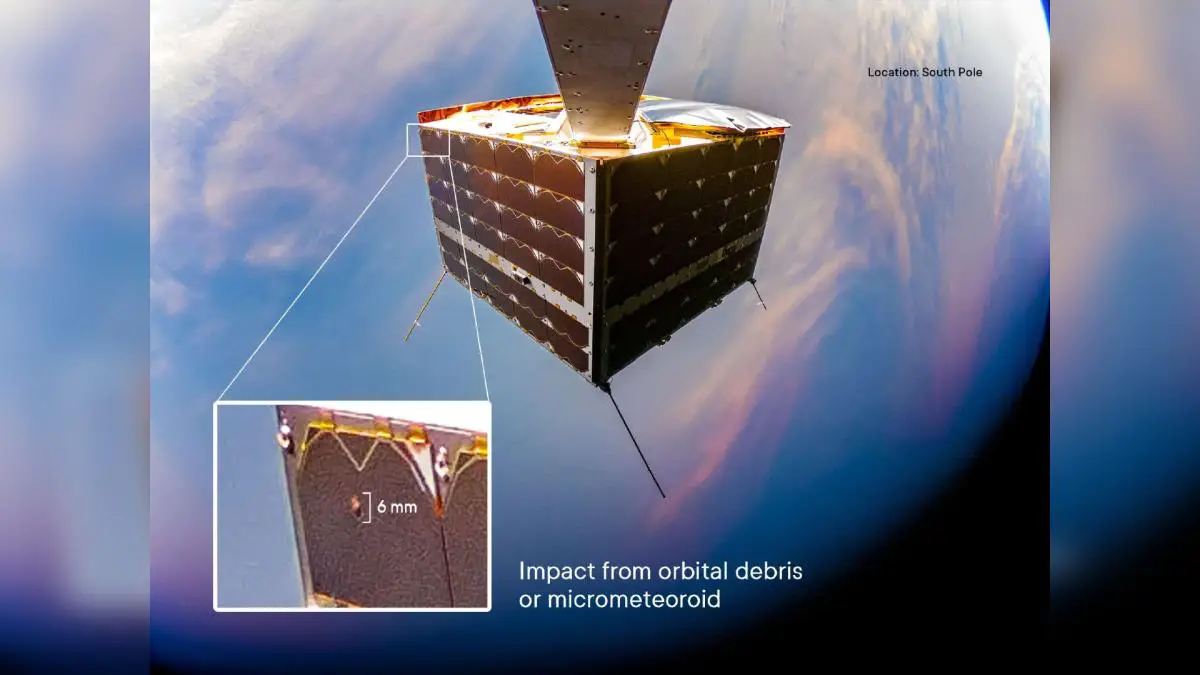When you buy through links on our articles, Future and its syndication partners may earn a commission.


A tiny puncture discovered in the solar panel of a small satellite orbiting Earth highlights the seriousness of the orbital clutter problem.
Lithuania-based satellite manufacturer NanoAvionics discovered the 0.24-inch-wide (6-millimeter) hole in footage captured by an on-board camera of its MP42 satellite, which has been orbiting the planet since April 2022. The satellite captured the image on Oct 24, and NanoAvionics released it on X on Wednesday, Oct 30.
The company said in a statement it wasn’t clear whether the puncture was caused by a tiny piece of space debris or a micrometeoroid. The firm is also unsure when the accident occurred as the onboard camera hadn’t taken a photo of the affected solar panel in 18 months prior to the discovery. Moreover, the hole is so small it caused no measurable drop in the solar panel’s electricity output.
“Whether this impact was from a micrometeoroid or a piece of space debris, the collision highlights the need for responsible space operations in orbit and makes us reflect on satellite resilience against these types of events,” NanoAvionics said in the statement.
NanoAvionics spacecraft are tiny. The largest satellite in the company’s portfolio is the 130-kg MP42 struck in the recent collision. Larger orbiting structures, such as the International Space Station, are at a greater risk of collisions.
That’s because a myriad of such small space debris fragments orbit Earth. The European Space Agency (ESA) estimates that 130 million space debris objects 0.4 to 0.4 inches in size (1 mm to 1 cm) hurtle around the planet. In 2016, one such fragment punched a 16-inch (40 cm) hole into the solar panel of ESA’s Earth-observing satellite Sentinel 1A. The collision affected the spacecraft’s power generation, but the mission recovered from the incident.
And in August 2023, a 246lb (112-kilogram) payload adapter left behind by Europe’s Vega rocket got struck by a similar piece of junk. The collision splintered off several fragments from the adapter, which had been the intended target of Europe’s first active space debris removal mission, ClearSpace-1. Safety concerns subsequently prompted ESA to choose another debris object to remove.
Most such strikes, however, remain undetected.


Larger pieces of space debris, though less numerous, can completely destroy a satellite. According to ESA, over 1,100,000 fragments 0.4 to 4 inches (1 to 10 cm) in size zip around Earth. In addition to that, 40,500 space debris objects larger than 4 inches (10 cm) inhabit space around Earth. Around 36,800 of these objects can be tracked, which means satellite operators can avoid them in case of a close approach.
NanoAvionics, which has launched nearly 50 satellites in the last decade, said the company has performed only “a handful of collision avoidance maneuvers” during that time.
“Most recently, in 2024, our mission operators executed a sequence of three firings using the satellite’s electric propulsion system, which lowered our customer’s collision probability with another object by several orders of magnitude,” NanoAvionics said in the statement.
RELATED STORIES:
— Debris from satellite breakup threatens other spacecraft, animation shows
— Space debris could be dealt with more cheaply than previously thought, new NASA report suggests
— Space is becoming an ‘unsustainable environment in the long term,’ ESA says
Space sustainability experts are concerned over the rising amounts of space debris in Earth’s orbit. One unfortunate smash-up between two large defunct objects could create thousands of out-of-control space debris fragments, which could remain in orbit for decades, threatening other spacecraft.
The worst in-orbit collision in the history of spaceflight took place in 2009 when an active satellite of the U.S. telecommunications constellation Iridium collided with a defunct Russian military satellite known as Kosmos 2251. The incident produced thousands of space debris fragments, many of which are still on orbit to this day.


Leave a Comment